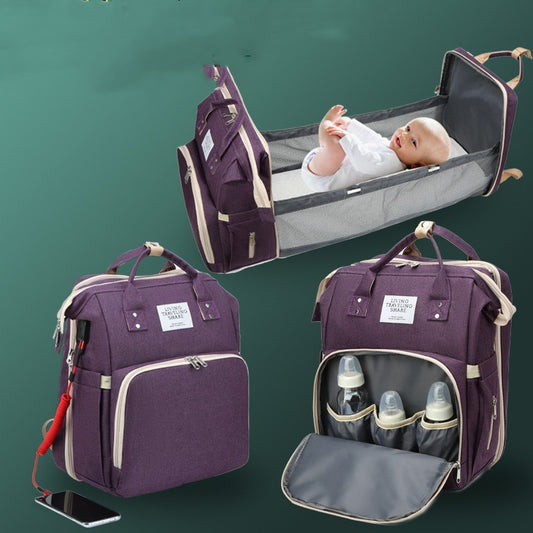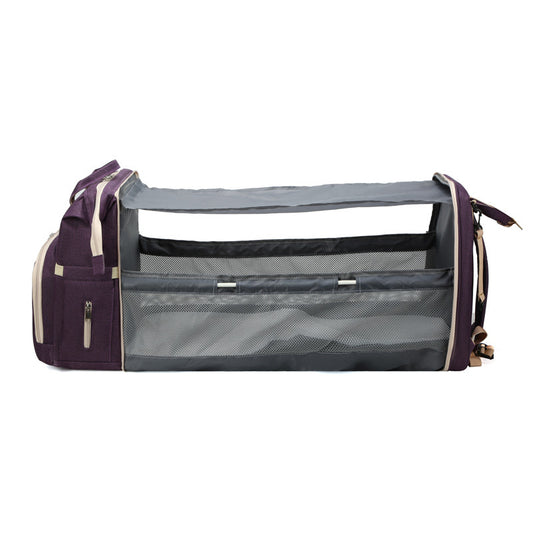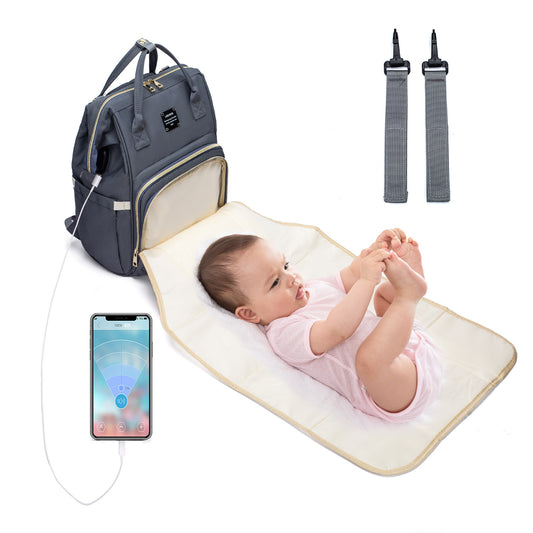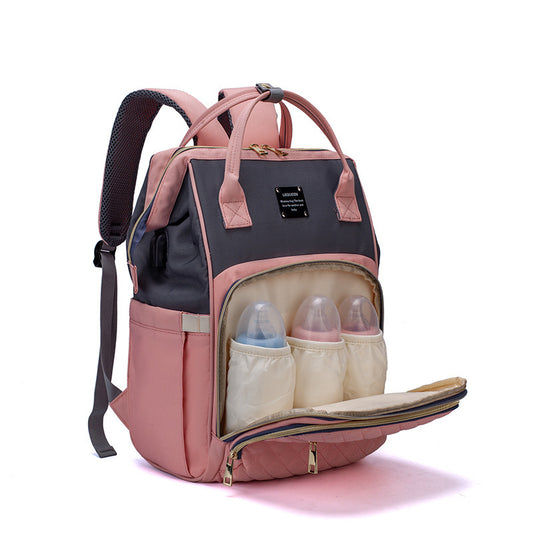If you're choosing a baby changing bag, there's a high chance you've come across the term “waterproof.” For many brands, it’s a standout selling point – but is it really essential, or is it just another overused label?
In this guide, we answer one key question:
Are waterproof baby changing bags genuinely practical, or are they overrated in real-world parenting life?
We explore what waterproofing truly means, when it’s valuable, what features make it effective, and whether it’s worth upgrading for UK parents handling unpredictable weather, leaking bottles, and everyday mess.
What Does “Waterproof” Really Mean in Baby Bags?
A baby bag labelled waterproof is designed to resist water ingress, both from outside (rain, snow, puddle splashes) and inside (leaking bottles, wet wipes, used clothes).
However, not all waterproof bags are created equal. There are three key types of water resistance:
-
Water-repellent (low) – Coated to resist light splashes but can absorb water in heavy rain
-
Water-resistant (moderate) – Holds up against accidental spills, splash-proof
-
Waterproof (high) – Designed to fully prevent liquids from entering or exiting, often with sealed liners or coatings
Most baby changing bags, including those on Kidyra.Store, fall under the water-resistant to waterproof level, made from durable Oxford fabric with waterproof internal linings.
Why Waterproof Baby Bags Are Practical
Waterproof bags offer clear benefits that apply to nearly every parenting scenario — especially when you're outside the home, exposed to weather, or carrying multiple liquid-related items.
1. Rain-Proof Protection for All-Weather Use
UK weather is rarely predictable. Whether you're walking to nursery, out at the park, or storing your bag under the buggy, a waterproof outer shell keeps:
-
Clothes dry
-
Nappies safe from damp
-
Food and toys protected
This is especially useful when public transport, pram parks, or outdoor benches leave your bag exposed.
2. Contains Interior Spills
From leaking formula bottles to wet wipes and half-sealed baby foods, messes are common. A waterproof interior ensures:
-
Milk or juice spills don’t soak through the entire bag
-
Moisture doesn’t ruin changing mats, emergency clothes, or tech (phone, power banks)
-
You can wipe clean and go
Kidyra’s bags, for example, feature insulated pockets and wipe-clean linings designed to minimise post-spill cleanup time.
3. Safer Organisation of Wet vs Dry Essentials
Waterproof compartments allow you to separate:
-
A soiled vest from a clean muslin
-
A used bib from a packed lunch
-
Moist cloths from cable chargers or parent wallets
This can be particularly valuable for travel, long days out, or if you’re already multi-tasking.
4. Protects Electronic Accessories
Modern baby changing bags now include USB ports and spaces for tech devices (e.g. your phone or power bank). Waterproofing stops catastrophic damage from:
-
Spilled bottles
-
Flipped pouches
-
Wet changing gear
If you’re carrying both parent gear and baby supplies, waterproof partitioning is more than just extra — it’s essential.
Cons or Limitations: Is Waterproof Just a Buzzword?
While waterproof bags are practical, there are a few things to consider.
1. Not Always Fully Waterproof
Many bags are only externally coated. The moment water soaks in via a pocket stitch, zipper or bottom seam, water can still penetrate.
Look for:
-
Sealed or laminated interiors
-
Reinforced zip seams
-
Structured base with no exposed stitching
Kidyra products use Oxford coated fabric with multiple layer lining, which offers mid-to-high level waterproofing fit for UK use.
2. Stiffness or Added Weight
Some waterproof fabrics (especially lower-grade PVC or double-coating nylon) can make bags bulky or heavier, especially when dry.
Modern waterproof bags using Oxford 600D+ or similar are lightweight while retaining resistance — which is why they’re favoured in most functional baby bags today.
3. False Marketing Terms
Watch out for brands labelling bags waterproof when they only offer:
-
Water resistance limited to the outer shell
-
No internal protection or separation
-
No zip sealing or wipeable linings
Be sure to review product descriptions carefully. If a bag is waterproof, the materials used will usually include PU-coated polyester, TPU-lined interiors, or sealed wet zones.
Waterproof Materials Commonly Used in Baby Bags
|
Material |
Waterproof Level |
Found in |
|
Oxford Polyester (600D/900D) |
High |
Most modern baby backpacks (e.g., Kidyra) |
|
PVC or PU Coated Fabric |
Moderate |
Some budget-friendly or fashion bags |
|
Nylon Ripstop |
Moderate |
Travel bags and hybrid models |
|
Waxed Canvas |
Low |
Natural look, but requires re-waxing |
|
Unlined Cotton |
None |
Avoid completely for baby care use |
Always consider both outer fabric and internal lining when making a waterproof material decision.
What Do Parents Say? Real Use Matters
Review data from featured products like the Kidyra Baby Changing Bag with USB Port and Foldable Mat Model show that waterproofing is frequently praised.
Common feedback includes:
-
“Easy to clean when a bottle leaked all over the inside.”
-
“I left the bag in rain — came back, and absolutely nothing was wet inside.”
-
“It didn’t smell after a damp bib sat inside all day. That’s a win.”
-
“Water-resistant outside is great, but what I love is the actual waterproof inside that stops mess soaking through.”
These responses highlight practical impact, not just labelling appeal.
Who Should Priorities Waterproof Baby Bags?
Waterproof baby changing bags are particularly valuable if you:
-
Live in the UK or other rain-prone areas
-
Use public transport or walk instead of driving daily
-
Pack bottles of milk, water, or juice frequently
-
Use your bag for nursery runs, daycare, or long trips
-
Share the bag with working partners who carry tech or papers
-
Need a wipe-and-go solution during busy schedules
Parents with indoor lifestyles may need it less, but nearly all will benefit at some point.
Conclusion: Are Waterproof Baby Changing Bags Worth It?
Yes — waterproof baby changing bags are practical and well worth it for most UK parents.
In a world of unpredictable spills, milk leaks, and British weather, a properly designed waterproof bag can save your essentials, protect your baby’s gear, and reduce your stress level.
While not every option labelled waterproof offers full coverage, choosing a high-quality multi-compartment bag with both inner and outer waterproofing ensures your investment pays off over time.
If you've ever spilled formula, used a changing mat in the rain, or had to wipe down your whole bag post-mess — then you already know the answer. Waterproof isn’t just a nice-to-have. It’s a need-to-have.
Call to Action
Looking for a waterproof, wipe-clean, and parent-approved baby changing bag?
Explore Kidyra.Store’s durable, waterproof Oxford fabric bags — designed for real-life parenting, whatever the weather.
Frequently Asked Questions (FAQs)
Q1. Are waterproof baby bags machine washable?
Not usually. Waterproof linings should be spot-cleaned or wiped. Machine washing can damage coatings or sealants unless otherwise specified on the label.
Q2. Can I add a waterproof lining to a regular bag?
You can use wet bags or inserts, but this doesn't protect against weather or larger spills. A full waterproof bag is still better for overall protection.
Q5. How can I check if a baby bag is actually waterproof?
Review the product specs. Look for terms like “Oxford fabric,” “PU coated,” “TPU lining,” and “insulated leakproof.” Reviews also help confirm real-world use.
Q6. Is water resistance enough for daily use?
For casual use, yes. But if you walk, travel, or carry milk/formula regularly, go for full waterproof interiors as well.
Q5. Does better waterproofing make the bag heavier?
Not necessarily. Modern materials like Oxford polyester are both lightweight and waterproof. Only older or cheaper PVC bags feel heavier.





